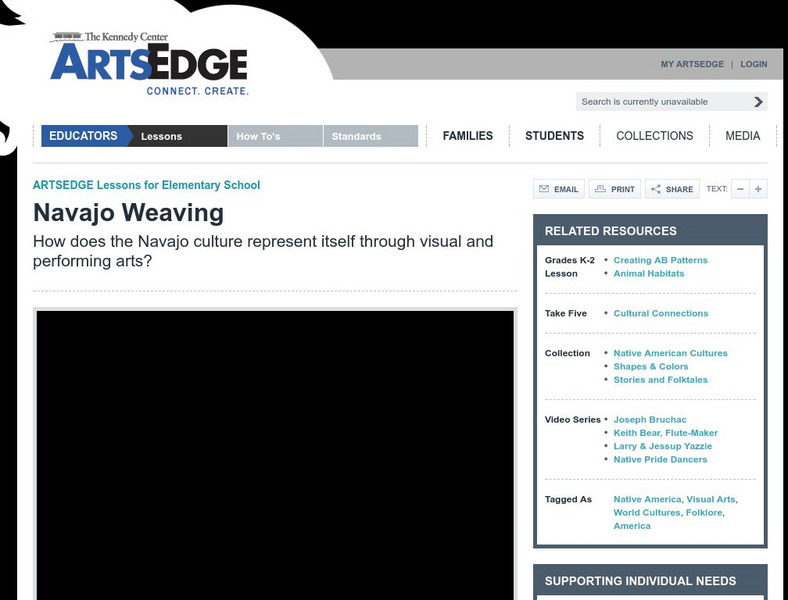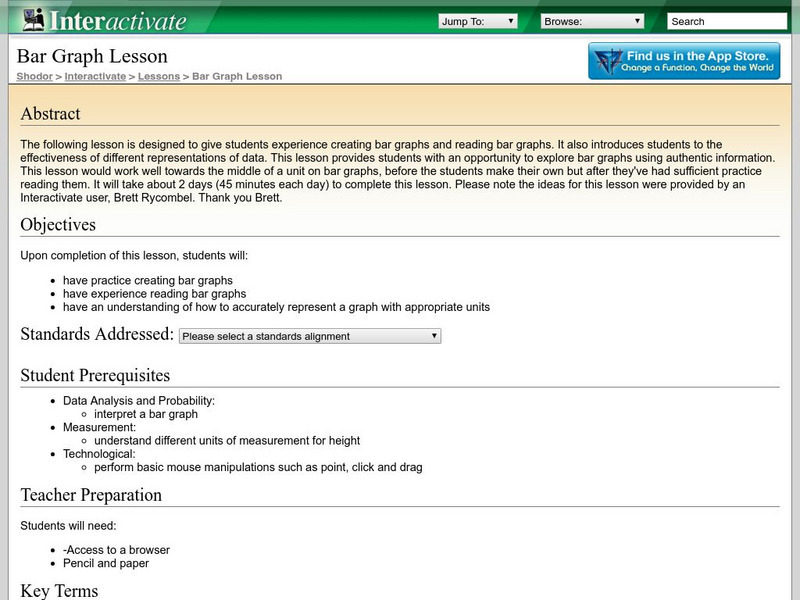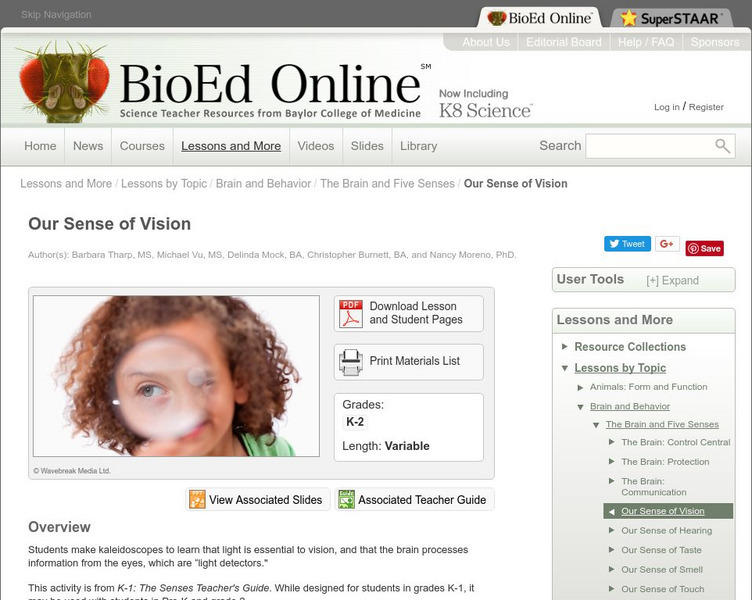John F. Kennedy Center
The Kennedy Center: Lesson: Navajo Weaving
Intergrating dance into your social studies lesson on the Navajo culture will give your students a glimpse into another way of life. They will use their knowledge of loom weaving, Native Americans, and creative dance to express these...
John F. Kennedy Center
The Kennedy Center: Brass Instruments and Pitch
Young scholars will enjoy making their own brass instrument with this interesting lesson plan. Objectives include what factors affect the pitch of brass instruments and what determines pitch.
John F. Kennedy Center
The Kennedy Center: Arts Edge: Navajo Weaving
After studying Navajo weaving and listening to the story "Ten Little Rabbits," students create their own interpretive dances. Contains an assessment checklist and extensions ideas.
Centers for Disease Control and Prevention
Centers for Disease Control: Kids' Quest on Disability and Health
KQ, the techno-health wizard, lets kids choose a WebQuest about a disability-related question they may have been wondering about. They get a page of activities and resources about Autism, Vision Impairment, Mobility Restriction, etc.,...
Centers for Disease Control and Prevention
Centers for Disease Control: Kids' Quest on Disability and Health
KQ, the techno-health wizard, lets kids choose a WebQuest about a disability-related question they may have been wondering about. They get a page of activities and resources about Autism, Vision Impairment, Mobility Restriction, etc.,...
PBS
Pbs Learning Media: Seven Selfish Shellfish
This video segment from Between the Lions features a classic tongue twister: a type of wordplay that helps children tune their ears to language and the sounds within words. [0:29]
Shodor Education Foundation
Shodor Interactivate: Lesson: Bar Graph
This lesson is designed to give students practice creating and reading bar graphs as well as understanding how to accurately represent a graph with appropriate units.
PBS
Pbs Learning Media: Classroom Tips
From managing the technology to tips for transporting video files, this resource offers practical advice and strategies for video use.
Science Buddies
Science Buddies: Project Ideas: Pet Poll: A Taste Test for Fluffy and Fido
In this mammalian biology science fair project, students will determine which brand, type, or flavor of treats their pet prefers. The Science Buddies project ideas are set up consistently beginning with an abstract, objective, and...
Science Buddies
Science Buddies: Toxic Trees: Just How Toxic Is That Black Walnut Tree?
The goal of this plant biology science fair project is to make and test an herbicide made from the leaves of the black walnut tree and investigate the toxicity of black walnut trees.
Science Buddies
Science Buddies: Are You in Hot Water? Use Solar Energy to Heat Your Own Water
The goal of this science fair project is to build batch solar collectors from different colors of plastic bags and see which collector is the most efficient in heating water.
PBS
Pbs Kids: Super Why: Princess Presto Spectacular Sounds Bingo
In this bingo game, listen for the sounds of the letters and click on the correct letter; when you have completed all the letters, a picture is revealed.
Huntington Library
Huntington Library: Garden Lesson Plans: Seeing Seeds [Pdf]
An exploration for younger students into the diversity of seeds and what is inside a seed. Includes extension activities.
Chase Young, PhD
Dr. Chase Young, Ph D: Reader's Theater Script: Arthur's Christmas [Pdf]
A reader's theater script for Marc Brown's children's book, Arthur's Christmas, is provided on these pages. Ten character roles are needed in this activity.
Chase Young, PhD
Dr. Chase Young, Ph D: Reader's Theater Script: Jack, the Cunning Thief [Pdf]
A reader's theater adaptation of the Celtic fairy tale, Jack, the Cunning Thief, is provided on this script. Seventeen character roles are needed in this performance.
Chase Young, PhD
Dr. Chase Young, Ph D: Reader's Theater Script: Helen Lester's Me First [Pdf]
A reader's theater script for Helen Lester's children's book, Me First, is provided on these pages. Eight character roles are needed in this activity.
Chase Young, PhD
Dr. Chase Young, Ph D: Reader's Theater Script: The Three Little Wolves and the Big Bad Pig [Pdf]
A reader's theater script for Eugene Triviza's children's picture book, The Three Little Wolves and the Big Bad Pig, is provided on these pages. Fifteen character roles are needed in this activity.
Chase Young, PhD
Dr. Chase Young, Ph D: Reader's Theater Script: Redheaded Robbie's Christmas Story [Pdf]
A reader's theater script for Bill Luttrel's children's book, Redheaded Robbie's Christmas Story, is provided on these pages. Ten character roles are needed in this activity.
BioEd Online
Bio Ed Online: Living Things and Their Needs: We Need Water
This activity focuses on living things' need for water. Students make lemonade and learn that water can be found in liquids other than a glass of water, and is also found in plants. The activity can be downloaded in PDF format.
BioEd Online
Bio Ed Online: Resources and Animals
In this lesson students will observe, examine, discuss and draw a walking stick insect or acrawfish in its natural environment in order to understand resources and animals.
BioEd Online
Bio Ed Online: Detecting Air Pollution
In this instructional activity students are asked to create model air pollution detectors to sample particles in indoor aiand outdoor air.
BioEd Online
Bio Ed Online: The Brain: Protection
What protects the brain? Why does the brain need to be protected? In this lesson students will learn about the fragility of the brain and that it is enclosed by the skull, which protects the brain and forms the shape of the head.
BioEd Online
Bio Ed Online: The Brain: Control Central
What do you know about the brain? In this early learners lesson, students will explore the basic functions and characteristics of the brain and skull, and also learn about three major structures in the brain: the cerebrum, cerebellum and...
BioEd Online
Bio Ed Online: Our Sense of Vision
Which parts of the body are involved in vision (seeing)? Is light important for vision? In this lesson plan students make kaleidoscopes to learn that light is essential to vision, and that the brain processes information from the eyes,...
















